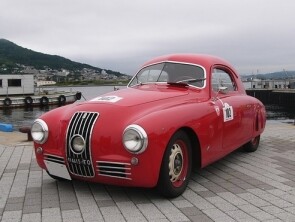
1948 Fiat 1100 S
ON/OFF
Why am I an Automotive Masterpiece?
The 1100 S was Fiat’s first post-war sports car, but it had a strong lineage with the pre-war 508C “Nuova Balilla” 1100, appeared in 1937. The car was intended as a Mille Miglia racer for the 1100cc class, the most popular at the time. The 1100 S was based on the light and rigid X-member frame of the 1100 B saloon. It featured a tuned engine and a dramatic streamlined body by Fiat which was loosely based off the pre-war 508 CMM with the peculiar "Gobbone" tail which had proved to be particularly effective for efficiency and helped the car achieve nearly 160 km/h. The two-seater body was produced by Carrozzerie Speciali at Fiat’s own Officine Lingotto under the direction of Giuseppe Cogno. Several of the early cars have a badge with this script on the body. The 1100 cc engine offered significantly more power than its predecessor and produced around 50 bhp. The S-spec engine had different camshafts and valves, a lubrication system with oil cooler, a centrifugal water pump with redesigned radiator and a crankshaft placed on four main bearings. Wind-tunnel testing allowed the 1100 S MM to reach speeds of 150 km/h, and 1100 S MMs gained 5th through 9th overall positions at the 1947 Mille Miglia, followed by a 2nd and 3rd overall in 1948. A number of 401 units of the 1100 S were made, but we suspect this might be an overambitious number that includes several other body styles. The chassis numbers went from 500001 to 500401. Despite the race purpose of the model, many 1100 S were sold to normal customers, convinced by the high speeds (over 150 kph) allowed by the powerful engine. Just following, the 1949 Fiat 1100 S Berlinetta is the first example of small series Pinin Farina cars built for Fiat. The 1100 S was followed by the 1100 E/S that was the sports version of the 1100 E saloon.
Vehicle with chassis 1100S*500160*. Characterized by a third central headlight set in the specially shaped central grille and two-tone red/cream rims. The car is matching numbers, with engine no. 500198. It was the subject of a monographic report in the Ruoteclassiche magazine in April 1997. It boasts a long career in re-enactment competitions for historic cars and participated in the re-enactment Mille Miglia. Equipped with a FIVA passport, the car kept the original black Turin plates (TO 114613) for a long time, before being part of a Japanese collection and then returning to Europe, in the hands of a German owner.





